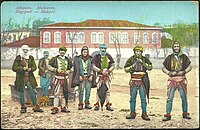
Kelmendi is a historical Albanian tribe (fis) and region in Malësia and eastern Montenegro. It is located in the upper valley of the Cem river and its tributaries in the Accursed Mountains range of the Dinaric Alps. The Vermosh river springs in the village of the same, which is Albania's northernmost village. Vermosh pours into Lake Plav.

Hoti is a historical Albanian tribe (fis) and sub-region of Malësia, a divided area located in northern Albania and southern Montenegro. Its geography is mostly mountainous, but some of its villages are on flat terrain near the banks of Lake of Shkodër.

Dukagjin Highlands is a mountainous region in northern Albania, east of Shkodra and north of the Drin. It is roughly equivalent to the northern half of the Shkodër District, with some minor parts in Malësi e Madhe District.

The Albanian tribes form a historical mode of social organization (farefisní) in Albania and the southwestern Balkans characterized by a common culture, often common patrilineal kinship ties tracing back to one progenitor and shared social ties. The fis stands at the center of Albanian organization based on kinship relations, a concept which can be found among southern Albanians also with the term farë.

Shala is a historical tribe and region of northern Albania in the valley of the river Shalë, in the Dukagjin highlands. At the end of the 19th century the tribe was Catholic and had c. 3,000 members. Today, descendants are widespread in Kosovo and are concentrated in Shala e Bajgorës.

The Nikaj are an historical Albanian tribe (fis) and region in the Highlands of Gjakova of north Albania. The Nikaj tribe is a traditional fis in the sense of being a community that claims paternal descent from one common ancestor, consisting of a single bajrak during the time of the Ottoman Empire. The Nikaj are directly related to the Krasniqi tribe. Today, the Nikaj are usually grouped along with the Mërturi tribe as Nikaj-Mërturi.

Shoshi is a historical Albanian tribe (fis) and region of northern Albania in the lower Shala valley. Shoshi is first recorded as a small settlement in 1485. The fis itself traces its origin to the brothers Gjol and Pep Suma. The community of their descendants gradually grew to control part of the Dukagjin highlands. In the 19th century Shoshi also became a bajrak.

Toplana is a historical Albanian tribe (fis) and ethnographic region located on the northern banks of the River Drin in northern Albania.

Mavriqi was an Albanian tribe (fis) that lived in the Middle Ages. They were the anas tribe of the Shala valley, being gradually expelled by the incoming Shala. The tribe gave its name to the modern village of Nënmavriq as well as to a number of micro-toponyms in the highlands of northern Albania.

The Highlands of Gjakova or Gjakova Highlands refers to the mountainous ethnographic region in the eastern Albanian Alps that sits between north-eastern Albania and western Kosovo, serving as the historical centres of the Albanian Gashi, Krasniqi, Bytyqi, Morina, Nikaj and Mërturi tribes. Traditionally, parts of the Gjakova Highlands that are now located in southern Montenegro were used as pasturelands by the local Albanian tribes.

The Rrjolli is a historical Albanian tribe (fis) and region in Malësia of north Albania. The tribal region is centred along the banks of the Rrjoll river that stems from Mount Bishkaz and empties into Lake Shkodër. The Rrjolli tribe is not a traditional fis in the sense of a community that claims paternal descent from one common ancestor; rather, it is polyphyletic. During the Ottoman period it formed a single bajrak.

Pult or Pulat, is a region in northern Albania. It is bordered by the Malësia Region to its north and by the Dukagjin Highlands to its east and its south. The region has traditionally been inhabited by the Plani, Kiri, Suma, Xhani, Drishti and Rrjolli tribes. The Pult region is situated on the Kir river and extends beyond Drisht to Prekal.

Kiri is a historical Albanian tribe (fis) and ethnographic region located on the eastern side of the upper Kir river in the wider region of Pulti, northern Albania.

The Suma are a historical Albanian tribe (fis) and tribal region in Pult of north Albania. During the Ottoman period it formed a single bajrak.

Boga is a region and former bajrak of the Kelmendi, a historical Albanian tribe (fis) and ethnographic region located in Malësia, northern Albania.

Xhani is a historical Albanian tribe (fis) and ethnographic region located on the western side of the upper Kir river in the wider region of Pulti, northern Albania.

The Manatia are a historical Albanian tribe (fis) and tribal region in the district of Lezha of northern Albania. It is one of the four traditional bajraks of the Highlands of Lezha, alongside the Kryezezi, Vela and Bulgëri.

The Vela are a historical Albanian tribe (fis) and tribal region in the districts of Lezha and Mirdita of northern Albania. It is one of the four traditional bajraks of the Highlands of Lezha, alongside the Bulgëri, Kryezezi and Manatia.

The Kushneni or Kuzhneni tribe are an Albanian tribe and one of the traditional bajraks of the Mirdita region in northern central Albania. The Kushneni tribe were one of the three traditional bajraks of Mirdita, which has now increased to five.

The Mërturi are an historical Albanian tribe (fis) and region in the Highlands of Gjakova of north Albania. The Mërturi tribe is a traditional fis in the sense of being a community that claims paternal descent from one common ancestor, consisting of a single bajrak during the time of the Ottoman Empire. The Mërturi are directly related to the Berisha tribe. Today, the Mërturi are usually grouped along with the Nikaj tribe as Nikaj-Mërturi.





